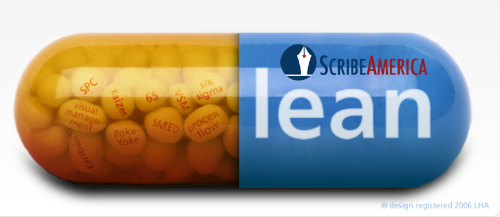Being a “lean organization” has become a popular catchphrase, and something most often associated with the world of tech startups. The term “Lean” as it refers to an organization has its origins in the lean manufacturing movement of the 1980’s and was popularized by the Japanese car company Toyota. In this model, Toyota knows how much each cup holder or visor costs but do we know the cost of each patient seen in the ED?
While the lean model has numerous success stories in the world of entrepreneurship, it’s not something you would think to apply to your hospital’s emergency department. But increasingly ED’s across the country are taking this approach, more often than not and with great success.
What it means to be lean
Being lean in this context is essentially optimizing the performance of your organization to produce a product or deliver a service, such as medical care, that is of the highest quality, but of the lowest cost with the minimum required staffing. Of course there’s a lot more that goes into adopting a lean vision, which we’ll go into later.
How it applies to your emergency department
All across the United States, ED volumes have been increasing for years. However, this year some are expected to decline as much as 10 percent. Their are many reasons for this drop; new flashy urgent cares on every corner, Telemedicine, and 7 million people recently losing their insurance. Accompanying that drop in volumes is a drop in reimbursement rates coupled with new mandates which are brewing for a perfect storm. Altogether that means lower revenues for hospitals trying to stay solvent in this new climate of health care reform. Meaning that the money is not there like it used to be and everyone from ED techs to physicians need to being doing more with less or jeopardize the ability to keep the hospital doors open.
This is a scary proposition to be faced with. Your initial reaction might be to panic, but while it might seem counterintuitive at first, this is the perfect time to optimize your ED operation using a lean approach.
If your hospital is going to survive and thrive through the next few years, running lean is the only option. When done properly, a lean ED will run with fewer staff members, meaning budget savings, while at the same time offering improvements in metrics like door to provider, total length of stay and left without being seen. Running lean can also improve your patient to provider ratio.
For example, let’s take a typical sized ED with an annual volume of 40,000 to 60,000. By thinking lean and focusing on the needs of the patient, you can cut staff and improve performance. An example of lean thinking would be direct bedding of patients or a direct admittance policy. A modern lean approach and budget pleaser is to cut some of the most expensive overhead, physician hours. I have talked to medical directors running the same schedule year to date and they are 6% down in volume. On one hand this is a great morale boost, your providers were seeing 2.0 patients per hour but are now at 1.75 but getting paid the same, unfortunately your ED is budget negative. If that same group cut 6% of their coverage they would be budget neutral. If they cut 10% and hired medical scribes to handle in parallel EHR documentation thus allowing a smaller staff to spend more time with patients and increasing productivity and throughput will allow you to make the needed reductions to stay profitable.
Lean thinking as a patient centric strategy
When developing the lean implementation plan for your ED it’s important to remember that lean thinking is a patient centric approach. A lean strategy should seek to address the following issues from a patient’s perspective:
- Reducing the time that the patient spends in the waiting room and faster initial medical contact.
- Making parallel processes of treatment predominate over serial processes.
-
Treating patients according to urgency, and thus indirectly according to resource needs.
Including medical staff in the lean thinking process
Your medical staff should be included in every aspect of the new strategy as all the changes being implemented will be carried out by them. To avoid the pitfalls of low staff morale or rejection of the new system, it’s important to include them in the process from as early on as possible.
They also need to know and understand the reasoning behind why a lean ideology is being implemented. As a matter of morale they need to know that while individual roles may change, and certain things will be done differently that ultimately the result will be a better organization. Setting obtainable and trackable goals that staff have agreed will also go a long way in bringing them on board with the changes.
The biggest obstacle is really the fear of change. To solve this problem, you should explain and demonstrate the need for change. It’s also important to provide adequate training and support for staff as well as to have confidence in the staff-led lean design team.
Popular lean thinking techniques
When it comes to actually creating a lean strategy every hospital is different. There is not a one sized fits all approach to becoming lean. But there are a few certain techniques that you can work through together with your staff to create the best lean plan for your organization.
This technique encourages the staff to develop their own thoughts about the appearance of delays, to then find a solution for these problems, and thus reduce frustration during the day.
Here the five S’s refer to: Sorting, Straightening, Sweeping, Standardizing and Sustaining. These items have to do with improving the appearance and organization of work areas.
This technique considers the issues from the patient’s perspective. Taking this approach can be very useful, especially because the non-medical members of the team can add their viewpoints.



